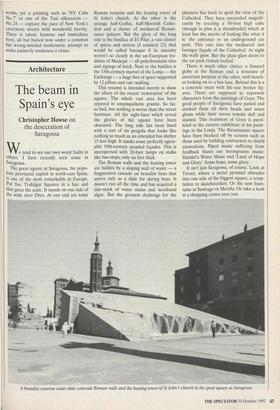Architecture
The beam in Spain's eye
Christopher Howse on the desecration of Saragossa We tend to see our own worst faults in others. I have recently seen some in Saragossa.
The great square at Saragossa, the popu- lous provincial capital in north-east Spain, Is one of the most remarkable in Europe. Put five Trafalgar Squares in a line and that gives the scale. It stands on one side of the wide river Ebro. At one end are some Roman remains and the leaning tower of St John's church. At the other is the strange half-Gothic, half-Moorish Cathe- dral and a cluster of mediaeval Renais- sance palaces. But the glory of the long side is the basilica of El Pilar, a vast cluster of spires and turrets (I counted 23) that would be called baroque if its ancestry weren't so clearly in the un-European tra- dition of Mudejar — all polychromatic tiles and zigzags of brick. Next to the basilica is the 15th-century marvel of the Lonja — the Exchange — a huge box of space supported by 12 pillars and van vaulting.
This resume is intended merely to show the idiocy of the recent `restoration' of the square. The whole vast area has been repaved in unsympathetic granite. So far, so bad, but nothing is worse than the street furniture. All the sight-lines which reveal the glories of the square have been obscured. The long side has been lined with a sort of tin pergola that looks like nothing so much as an extended bus shelter 15 feet high. It masks some perfectly agree- able 19th-century arcaded façades. This is interspersed with 20-foot lamps on stalks like bus-stops, only six feet thick.
The Roman walls and the leaning tower are hidden by a sloping wall of water — a fragmented cascade on brutalist lines that serves only as a slide for daring boys. It doesn't run all the time and has acquired a tide-mark of water stains and moribund algae. But the greatest challenge for the planners has been to spoil the view of the Cathedral. They have succeeded magnifi- cently by erecting a 30-foot high cube (though in plan it is rhomboidal) which at least has the merits of looking like what it is: the entrance to an underground car park. This cuts into the mediaeval and baroque façade of the Cathedral. At night the walls glow. But the plate-glass doors to the car park remain locked.
There is much other clutter: a fissured globe at the Roman end, a structure of uncertain purpose at the other, with bench- es looking on to a bus lane. Behind this is a a concrete maze with life-size bronze fig- ures. These are supposed to represent characters from the paintings of Goya. The good people of Saragossa have patted and stroked them till their heads and noses gleam while their torsos remain dull and stained. This treatment of Goya is paral- leled in the current exhibition of his paint- ings in the Lonja. The Renaissance spaces have been blocked off by screens such as those used by building contractors to shield excavations. Piped music suffering from feedback blares out incongruous music: Handel's Water Music and 'Land of Hope and Glory'. Some hope, some glory.
It isn't just Saragossa, of course. Look at Teruel, where a metal pyramid obtrudes into one side of the biggest square, a temp- tation to skateboarders. Or the new foun- tains at Santiago or Merida. Or take a look at a shopping centre near you.
A brutalist concrete water-slide conceals Roman walls and the leaning tower of St John's church in the great square at Saragossa


























































 Previous page
Previous page